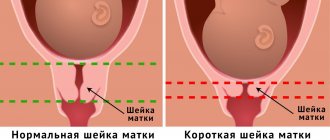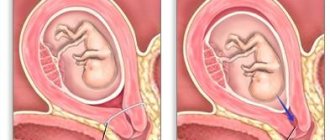Does the uterus enlarge before menstruation?
Before menstruation, the size of the uterus changes, which is due to the physiological characteristics of the female body, and an increase in its size before the onset of menstruation is acceptable.
But the uterus also increases in size if pathological changes begin in the female genital area. This may be a menstrual disorder, sexually transmitted diseases, or the presence of a malignant neoplasm. The gynecologist knows exactly what a healthy uterus should look like at different periods of the menstrual cycle, so he will be able to determine whether there is a deviation. It should also be said that the cervix should be checked at least once a year, preferably during ovulation or before menstruation.
And to understand the reasons why the uterus enlarges before menstruation and how normal this is, you need to know what the menstrual cycle is.
The premenstrual period is characterized by certain changes in the female body and reproductive system. Before menstruation, the cervix drops, its edges become loose, and it itself is soft and slightly open. All practicing gynecologists know exactly how the cervix should correspond to a certain period of the menstrual cycle.
Shortly before menstruation, a woman’s body prepares to reject the old uterine epithelium and blood fibers, which is why the cervix smoothes out a little and opens slightly, allowing all secretions to leave the uterus. Thus, a complete menstrual cycle passes, and after the completion of menstruation and the ovulation period, menstruation begins again.
Before menstruation, the cervix becomes loose and soft to the touch. It descends lower and slightly misses the tip of the finger (in women who have given birth this is more pronounced). That is why during menstruation you need to be especially careful about personal hygiene, use natural, comfortable underwear and regularly change your sanitary pad or tampon.
When the cervix is slightly open, there is a possibility of infections being introduced inside, which can cause the development of dangerous diseases or inflammation of the genital organs, which can subsequently cause adhesions in the fallopian tubes and lead to infertility.
During pregnancy, the cervix rises as high as possible in the vagina; upon examination, it can only be felt with a fingertip. It will be very hard and dense, and the hole will look like a small flat slit. Knowing what the cervix is like before menstruation, you can compare whether it is prepared for the start of the cycle.
During pregnancy, the length of the cervix also increases (becomes more than 2.5 cm). If it begins to decrease before the appointed time, it means that the risk of premature birth or spontaneous abortion increases.
During pregnancy, an examination allows you to determine the likelihood of a miscarriage, since the cervix during this period should be long and dense, but if its length becomes less than 2.5 cm, the doctor should prescribe additional examinations or hospitalization of the pregnant woman to prevent premature birth or miscarriage.
Shortly before childbirth, examination of the cervix allows you to determine the readiness of a woman’s birth canal for the start of labor. At this time, the neck should be shortened, smoothed and allow 1-2 fingers into the pharynx.
The cervix before menstruation and during pregnancy has its own characteristics that allow doctors to determine a woman’s condition without conducting additional examinations, if they are not currently possible. The doctor can make a final conclusion only after a complete examination of the body.
The uterus is an important female reproductive organ. It is where the growth and development of the fetus occurs. Thanks to its special structure, it prevents harmful microorganisms from reaching it and protects the child from external factors and shocks.
The cervix of the reproductive organ is a tube that connects the vagina to the uterus (you can see what it looks like in the photo). Depending on the period of the cycle and the age of the woman, it changes. In women who have not given birth, the cervix is more elastic and has the shape of a cylinder and is located low. After childbirth, it softens and takes on a more rounded shape. The length of the neck reaches 4 cm, width – 2.5 cm.
The cervix consists of the vaginal and supravaginal zones. In its center is the cervical canal with the internal and external pharynx. The internal pharynx is directed towards the cavity of the reproductive organ, the external pharynx is visible from the side of the vagina upon examination.
There is always a special fluid in the cervical canal. It is necessary to protect the uterus from the effects and penetration of pathological microorganisms. During and before menstruation, fluid ensures complete release of blood discharge.
Experienced gynecologists can understand what is happening in a woman’s body after examination. The main criteria are density, openness of the channel and released fluid. During examination, it is important to determine which part of the organ is located most highly or pathologically low. At different times, the color of the internal genital organs also changes. They have a pink tint on normal days and a bright red and blue color when pregnant.
During ovulation
Ovulation is the process of releasing a mature egg. She prepares for fertilization from the beginning of the menstrual cycle and fully matures on days 14–16. During ovulation, the cervix is high and has a loose structure. The pharynx of the reproductive organ opens slightly. A large amount of fluid is released from the cervical canal, which facilitates the rapid penetration of sperm into the uterine cavity.
Many women note the appearance of nagging pain in the lower abdomen at this time. This is due to the release of the egg. Many experience an increase in sexual desire, swelling of the mammary glands and an increase in their sensitivity.
After ovulation, the body produces large amounts of the hormone progesterone. Under its influence, the uterus is located low, hardens and closes. The amount of mucus secreted decreases, the cervix becomes dry. This is necessary to block the entry of germs. At this time, it is also difficult for sperm to reach the egg; this period is considered unsuitable for conception.
On the eve of menstruation
Before menstruation, the uterus is located lower, the cervix is tightly closed. It is hard to the touch, mucus is released in small quantities. The vagina is dry due to a small amount of mucus secreted before menstruation. The uterine cavity does not change; before menstruation it remains of normal size.
During menstruation, the cervix drops and becomes soft. The uterus itself increases in size during menstruation. The throat of the cervix opens slightly, the edges are smoothed. In this case, such a condition is necessary not for rapid fertilization, but for the release of menstrual flow. In the uterus, the outer layer of the mucous surface is rejected. The endometrium comes out gradually, separating in layers.
During this period, special attention must be paid to hygiene. A slightly open pharynx allows microorganisms to easily penetrate the internal genital organs. To avoid infection you should:
- wash yourself after each urination, moving from the vagina to the anus;
- change sanitary pads or tampons promptly;
- wear comfortable underwear made from natural fabrics;
- Avoid swimming in open water and visiting public baths and saunas.
What does the cervix look like before menstruation?
The premenstrual period is characterized by certain changes in the female body and reproductive system. Before menstruation, the cervix drops, its edges become loose, and it itself is soft and slightly open. All practicing gynecologists know exactly how the cervix should correspond to a certain period of the menstrual cycle.
Shortly before menstruation, a woman’s body prepares to reject the old uterine epithelium and blood fibers, which is why the cervix smoothes out a little and opens slightly, allowing all secretions to leave the uterus. Thus, a complete menstrual cycle passes, and after the completion of menstruation and the ovulation period, menstruation begins again.
About the menstrual cycle
On the eve of menstruation
The menstrual cycle should be understood as a period of time that lasts approximately a month when complex processes take place in a woman’s body aimed at preparing for conception. The menstrual cycle is characterized by different durations for different representatives of the fair sex. How many days does the menstrual cycle last?
There are certain indicators that characterize a normal menstrual cycle, namely: the regularity and duration of menstruation, the volume of discharge.
An important component of the menstrual cycle is menstruation. This is spotting that occurs every month from puberty until menopause. As a rule, girls have their first periods at the age of 11-16 years; within a year, menstruation becomes regular and the cycle normalizes. The last menstruation in women is approximately at the age of 50-52 years, when the production of sex hormones in the female body decreases and menopause occurs.
During pregnancy and breastfeeding, menstruation stops.
The entire menstrual cycle can be divided into several phases. The first phase is characterized by the production of sex hormones necessary for the maturation of the follicle. Afterwards, ovulation begins, occurring approximately in the middle of the cycle. A mature egg emerges from the follicle, and the third phase begins, characterized by changes in the membrane.
The entrance to the uterine cavity changes in different periods of the cycle. The cyclic work of the ovaries goes through the ovulatory, follicular and luteal phases. Uterine functions change from secretory to menstrual and proliferative.
The composition of the fluid in the cervical canal also changes. It can be studied in detail in laboratory conditions. At home, a woman can analyze the consistency.
The cervix feels like this:
- Soft.
- Elastic.
- Dense.
- Loose.
- Solid.
Its position is either high or low.
Secretory stage
The tone of the uterus in the 2nd half of the cycle decreases and after ovulation, closer to menstruation, the cervix becomes soft. The external pharynx opens to such an extent that the tip of the finger penetrates inside.
The high position of the cervix helps sperm reach the fallopian tube faster. The glandular part of the cervical canal intensively produces transparent whitish mucus. The alkaline index of the secretion reaches 8 units. The mucus doesn't stretch.
In the absence of a fertilized egg, the body begins to prepare for endometrial rejection. A plug forms in the canal, the neck hardens and falls. The pharynx closes, the cervical canal narrows. In case of pregnancy, the cervix does not change its position. It will be difficult to feel the pharynx manually at home.
Experts know exactly what the cervix looks like on the eve of menstruation, and characterize it as follows:
- Located below.
- It has a loose soft surface.
- The external pharynx is open, the canal is expanded.
- Little cervical mucus is produced.
- The secretion has a sticky, thick consistency.
- pH{amp}lt; 6.5 units
At the proliferation stage, the endometrium is restored in the uterus. It forms its own connective substances and blood network. The proliferative stage lasts until ovulation occurs. It begins in the 2nd half of the follicular phase.
After menstruation, the cervix undergoes changes again:
- Descends into the vagina.
- The external pharynx narrows greatly.
- The endocervix becomes denser.
- The amount of cervical fluid increases.
- The pH level gradually increases to 7.3 units.
Critical days are a difficult stage for the body. You are not feeling well and your genitals are at risk of infection. For this reason, it is not recommended to examine the uterus manually, and it is not recommended to constantly use hygienic tampons.
During the menstrual period, the cervix has other characteristics:
- She's hanging low.
- He is in low tone.
- The acidity level is approaching 7 units.
- The vaginal epithelium is slightly flaky.
- Cervical fluid is secreted in moderate volumes.
- The external pharynx is slightly open, the opening is directed towards the vaginal vault.
Daily palpation of the cervix, including before menstruation, helps to track cyclic changes. In order not to injure or infect a delicate organ, it is necessary to cut off the nail on the desired finger and polish the edge of the plate.
For greater safety, it is better to perform the procedure with sterile gloves or a fingertip. It is recommended to record all data collected before the onset of bleeding in a notebook.
The purpose of diagnosis is to assess the position of the cervix before menstruation and during other phases of the cycle, as well as during pregnancy, if it has occurred. It is also important to know the density of the organ at the proliferative and secretory stages of MC.
The information collected over several months will help the woman with family planning and will signal the need to see a doctor if there are any abnormalities.
Advantages and disadvantages of self-examination
What can the self-diagnosis result say? Let's try to answer this question:
- The uterine canal is slightly open the day before and during menstruation, which means the risk of infection increases. Afterwards, this may manifest itself as inflammation of the uterine appendages, and subsequent complications, including infertility;
- A careless inspection at home can lead to a seemingly minor injury. Afterwards, erosions appear in such places, which can be complicated by infection;
- Even extensive experience in independent examinations will not help to give an adequate assessment of the condition of the uterus. Remember that even a doctor, in addition to his hands, uses additional tools;
- The doctor is able to visually see changes by combining them with palpation data. It is impossible to see the condition of the cervical canal on your own.
Thickening of the uterine wall does not always indicate a serious pathology. In some cases, this is due to hormonal changes. To determine the real cause of the thickening, a detailed examination should be performed. Often, wall thickness is detected during ultrasound, hysteroscopy, and MRI. An ordinary examination by a gynecologist is not a diagnostic method for thickening, since the doctor cannot visually determine the exact size of the deviation from the norm.
The walls of the uterus are divided into three layers in their structure. The inside of the organ cavity is covered with a mucous membrane; the outside of the uterus is covered with a serous layer. Between them is the myometrium, a muscle layer that is of great importance for many functions of the female body. It is responsible for the contraction of the uterus during and after childbirth, as well as during menstruation. The endometrium, that is, the inner layer, has certain functions during ovulation, menstruation, and in the first days of pregnancy.
When the wall thickens, we are usually talking about an increase in the muscle layer; such changes (often in the anterior wall) can accompany menstruation or pregnancy, but if the increase in thickness is significant, then you should think about a more thorough examination to prevent dangerous pathologies.
What's inside?
A woman's egg is released from the follicle every month and is ready to be fertilized by a sperm. If there was no sexual intercourse at this time, and therefore there was no fertilization, bleeding begins. Thanks to monthly bleeding, the body is cleansed and prepared for the next cycle.
When an unfertilized egg enters, the uterus is very sensitive to the effects of progestin hormones, which ensure conception and development of the fetus in the womb. During this period, many representatives of the fair sex may experience sudden changes in mood, increased irritability, so much so that it is difficult to control themselves, and health problems appear. As a rule, all the unpleasant symptoms of premenstrual syndrome end with the onset of menstruation.
The uterus enlarges before menstruation, the cervix of the organ descends and becomes soft. If there has been no conception, the cervix will be raised high and become hard. But, such a condition of the reproductive organ may indicate diseases of the genital area, so you cannot do without consulting a gynecologist. But, before going to the doctor, you can conduct a self-diagnosis of the uterus and its cervix.
General information about the cervix and its examination
Before menstruation, the cervix becomes softer to the touch and does not provide reliable protection against infections, so the examination must be carried out carefully and all safety recommendations must be followed.
To avoid introducing infection into the uterus, you need to cut your legs short, wash your hands (it is better to wear sterile medical gloves) and insert two fingers into the vagina. Before menstruation, when the cervix is slightly lowered and slightly open, with the middle phalanx of the finger you can feel a small tubercle, in the center of which there is a small round hole.
If pregnancy occurs in the last cycle, then on the due date of the start of menstruation, the cervix will be located very high in the vagina. In addition, it will have a very hard and dense consistency and will not let your finger through even a millimeter (that is, the hole is tightly closed and represents a small gap).
Knowing what the cervix should be like before menstruation, you can easily determine its onset, the period of ovulation, and the presence of pregnancy. But you need to know that even an examination will not allow you to draw a final conclusion, since each female body is individual.
Most often, gynecologists do not recommend examining the cervix yourself. This is due to several reasons:
- Due to the slightly open opening, there is an increased risk of pathogenic bacteria entering the uterus, which can cause gynecological diseases, in particular, such as tubal adhesions, inflammation of the ovaries, which can ultimately lead to infertility in a woman.
- The position of the cervix before menstruation changes, and it lowers slightly into the vagina, so with a careless examination, you can easily injure the cervix, thereby causing the development of erosion, which, if there is any infection in the woman’s vagina, will cause a deterioration in the condition and, in some cases, contribute to the appearance of tumors.
- It is impossible to accurately assess the condition of the cervix on your own, since the gynecologist, in addition to his fingers, uses a special mirror for examination, which allows him to accurately determine the condition of the cervix.
- Even the most experienced doctor will never make a conclusion about an existing pregnancy only on the basis of an examination, since it is necessary to take into account other facts and individual characteristics of the body.
The cervix before menstruation only suggests the imminent onset of menstruation or the presence of pregnancy, which is a reason to undergo additional examinations. Most often this is a pregnancy test and a blood test for hCG.
Regular examination is primarily necessary for the timely detection of developing tumors, malignant or benign, since even at an early stage of the development of the disease there are certain signs, and it is at this time that treatment can be most effectively carried out.
Since modern technologies have not yet reached all corners of the Earth and in some villages there are no ultrasound machines familiar to us, gynecologists, through examination, determine the condition of a woman’s reproductive system by the shape of the pharynx. The cervix before menstruation has the shape of a pupil, but if the shape changes, then we can conclude that there is a lack of estrogen or a dysfunction of the corpus luteum.
On the eve of menstruation
After conception in the early stages, characteristic changes begin in a woman’s body. First of all, the uterus changes: it becomes softer, and the pharynx becomes harder. Visible signs appear a few weeks after fertilization. This time is necessary for the egg to enter the uterine cavity from the fallopian tubes and attach to its surface. After this, changes occur under the influence of the hCG hormone.
The neck of the reproductive organ is located high, while the pharynx does not allow a finger to pass through during examination. Upon examination, it can only be felt with the tip of a finger; the pharynx is compressed. The color of the neck changes, it acquires a bluish tint. This is due to an increase in the intensity of blood supply to the organ.
It will not be possible to examine the genitals as at a gynecological appointment at home due to their location. The doctor uses special instruments that allow you to carefully examine the surface of the vagina and the condition of the cervix. You can examine them yourself only by palpation (you shouldn’t do this before your period).
Technique:
- wash your hands thoroughly with soap;
- cut your nails;
- put on gynecological gloves;
- take a comfortable position;
- gently insert the middle and index fingers into the vagina;
- feel the tubercle.
Based on the condition of this tubercle, a preliminary conclusion can be made about a possible pregnancy. The uterus before menstruation is located lower, the cervix is easy to find. It is slightly open and soft to the touch. When pregnancy occurs, the cervix rises high and can only be felt with a fingertip. The pharynx is closed and does not allow a finger to enter.
Experts do not recommend palpation at home without the necessary knowledge and experience. The reasons for this are explained by the following risks:
- Getting infected. An open cervix before menstruation promotes infection.
- Cervical injury. Quick and rough movements can easily scratch the inside of your cervix, which increases the risk of serious infection before your period.
Of course, it is better for the diagnosis to be carried out by a specialist, but if you still decide to examine yourself for peace of mind, it is important to follow the rules.
- You need to understand that during the self-examination, your hands should be clean, cut your nails as short as possible, and wear a sterile glove.
- It is impossible to diagnose the vagina during menstruation and a few days before its onset.
- It is more convenient to carry out diagnostics in a sitting position; you can squat.
- Sharp and rough movements are unacceptable so as not to injure the vagina.
After a comfortable position has been adopted, the middle and ring fingers should be inserted into the vagina until they touch the cervix. If the middle finger rests easily on the neck of the organ, this indicates its lower position (the state before the onset of menstruation). If it is difficult to reach the cervix, this means that it has shrunk (this happens after menstruation).
From this we can conclude that only regular examinations by a gynecologist will help monitor the condition of the genital organs and promptly detect and eliminate problems.
Many pregnant women are interested in the question of what the cervix feels like to the touch during early pregnancy. For a woman, this condition is a special period in life when changes occur not only in life, but also in the body. Some of them relate to the external manifestations of pregnancy, but there are also those that are not noticeable to prying eyes.
Not only the uterus during pregnancy, but also other female genital organs change greatly; these metamorphoses are felt by the expectant mother. During the period of fertilization and bearing the baby, the cervix becomes different to the touch. Already in the early stages, a woman may suspect the fact of fertilization of the egg; during the examination, the gynecologist checks what the uterus looks like, after which the woman is sent for an ultrasound examination to confirm conception. This procedure can provide more accurate information and confirm the pre-set deadline.
The uterus undergoes significant changes during pregnancy. After conception, a woman should be more attentive to her health and not ignore changes that signal possible pathologies. If, after the first examination, the fact of fertilization is established, then the cervix should be checked throughout the entire period of gestation.
This will help avoid complications and promptly identify some pathologies and diseases. In 9 months, the woman will have to visit a doctor in order to get tested for flora. For this purpose, a smear is taken, and cytology tests are also performed. These basic procedures are performed at least 4 times. A special schedule for such examinations is provided.
This canal is one of the most important organs not only for the woman, but also for the child during childbirth. This is the path for the baby through which he is born. Therefore, it is very important to monitor the condition of this part of the uterus.
When examined by a specialist, the location of the cervix must be taken into account. It can be lowered or raised. What influences these changes? In the normal state, when there has been no fusion of the egg with the sperm, the tube is elevated. But at the moment of fertilization, progesterone stimulates its descent. In this way, a protective function is performed for the fertilized egg, which prevents it from slipping out of the uterus.
An experienced doctor is able to determine pregnancy and its duration just by looking at the cervix. If the egg is fertilized and the cervix is still elevated during pregnancy, the doctor may admit the patient to the hospital in order to save the fetus, since in this condition there is a risk of miscarriage. But you shouldn’t panic right away, since this location of the cervix can be determined by the individual characteristics of the woman’s genital organs.
The position of the uterus during early pregnancy does not change, but over time, when the fertilized egg turns into a fetus, it increases significantly in size. It is very important to monitor the cervix not only in the early stages of pregnancy; any changes that may threaten premature birth or miscarriage can be predicted by the appearance of the canal.
The state of women's health depends on how the cervix looks in the early stages of pregnancy. During early fertilization, it becomes softer, this is due to the action of progesterone and increased blood circulation in this organ. If a woman has hypertonicity, which is dangerous for the baby’s health, then upon examination this part of the uterus will be hard. In such cases, it is necessary to take measures to eliminate the threat of miscarriage.
The specialist may recommend bed rest, calmness, and medication. It is possible to preserve the health of the woman and fetus in the pathology department. The earlier intrauterine pregnancy is diagnosed, the greater the chance that examination will reveal changes that are not typical for this condition. Then the necessary measures will be taken for the normal course of pregnancy.
Secretory stage
How to conduct an inspection correctly
Before menstruation, the cervix becomes softer to the touch and does not provide reliable protection against infections, so the examination must be carried out carefully and all safety recommendations must be followed.
To avoid introducing infection into the uterus, you need to cut your legs short, wash your hands (it is better to wear sterile medical gloves) and insert two fingers into the vagina. Before menstruation, when the cervix is slightly lowered and slightly open, with the middle phalanx of the finger you can feel a small tubercle, in the center of which there is a small round hole.
If pregnancy occurs in the last cycle, then on the due date of the start of menstruation, the cervix will be located very high in the vagina. In addition, it will have a very hard and dense consistency and will not let your finger through even a millimeter (that is, the hole is tightly closed and represents a small gap).
Knowing what the cervix should be like before menstruation, you can easily determine its onset, the period of ovulation, and the presence of pregnancy. But you need to know that even an examination will not allow you to draw a final conclusion, since each female body is individual.
What do the changes mean?
Many women do a test when their period is late. If it gives a positive result, then it is advisable to contact the gynecological department for examination and receive further doctor’s recommendations. The doctor will definitely examine you in a gynecological chair. Why is this necessary and what information will the doctor receive as a result of this examination?
- 1. Appearance of the cervix. Her condition is one of the most important signs confirming the fact of successful fertilization.
- 2. The size of the internal genital organs, namely the uterus and its cervix, confirms the period that was initially determined by the last menstruation. If they coincide, then this indicates a normal pregnancy in the early stages.
- 3. As a result of the examination, ectopic pregnancy and other possible pathologies should be excluded or confirmed.
The uterus remains virtually unchanged during early pregnancy, but the same cannot be said about its cervix. An experienced doctor, upon examination, can immediately establish the fact of an interesting position of a woman.
Why don’t doctors advise doing a self-examination of the cervix?
Most often, gynecologists do not recommend examining the cervix yourself. This is due to several reasons:
- Due to the slightly open opening, there is an increased risk of pathogenic bacteria entering the uterus, which can cause gynecological diseases, in particular, such as tubal adhesions, inflammation of the ovaries, which can ultimately lead to infertility in a woman.
- The position of the cervix before menstruation changes, and it lowers slightly into the vagina, so with a careless examination, you can easily injure the cervix, thereby causing the development of erosion, which, if there is any infection in the woman’s vagina, will cause a deterioration in the condition and, in some cases, contribute to the appearance of tumors.
- It is impossible to accurately assess the condition of the cervix on your own, since the gynecologist, in addition to his fingers, uses a special mirror for examination, which allows him to accurately determine the condition of the cervix.
- Even the most experienced doctor will never make a conclusion about an existing pregnancy only on the basis of an examination, since it is necessary to take into account other facts and individual characteristics of the body.
The cervix before menstruation only suggests the imminent onset of menstruation or the presence of pregnancy, which is a reason to undergo additional examinations. Most often this is a pregnancy test and a blood test for hCG.
General information about the cervix and its examination
A woman can independently feel this area at home by completely immersing her middle finger into the genital tract. As soon as the fingertip touches the bulge, there is no need to move further - the desired element has been found.
By doing such diagnostics every day for several cycles, a woman will learn to determine the position of the cervix before menstruation, calculate ovulation and select days favorable for conception. Or vice versa, he will understand on which days it is necessary to strengthen contraceptive measures.
The doctor examines the patient's genital tract on a chair using a special mirror. At home, it will be convenient for a woman to examine the cervix in several positions:
- Sitting on the toilet.
- Squatting.
- Standing, but one leg placed high.
The study is not carried out during menstruation. On “clean” days, the organ is felt once a day before bed at the same time. If a gynecological disease of an infectious-inflammatory nature is suspected or with the onset of bleeding, the diagnosis is canceled.
The speed of its detection helps determine whether the cervix is high or low on a particular day. If the location is high, the area is difficult to palpate; if it is low, it can be detected immediately. The amount of openness is judged by the recess. If a small gap is felt, the uterus is closed. If the hole is round and deep, then the organ is open.
Despite the simplicity of this method, doctors do not recommend examining internal organs yourself. The ban is justified for the following reasons:
- When the hole is open, there is a risk of damage to the uterus by pathogenic bacteria. Because of them, the ovaries become inflamed and obstruction of the fallopian tubes develops. In advanced cases, the disease can result in infertility.
- Since the cervix drops slightly before menstruation, inept palpation can injure it and provoke the development of erosion. The pathological focus is susceptible to infection and is dangerous in terms of oncological degeneration.
- The woman does not see the true state of the uterus. The gynecologist evaluates the real picture visually using a mirror.
A woman's internal genital organs are the uterus, which connects to the vagina. Between these organs is the cervix - this is the lower part of the uterus. Externally, it can be described as a tube approximately 4 cm long and about 2.5 cm in diameter. When examining a woman, the gynecologist checks only the part that is visible through the vagina.
In the period after fertilization, blood circulation becomes more intense, which is why the color of the cervix changes. In addition, it becomes softer to the touch. Her condition gives the gynecologist almost all the necessary information about whether the woman is currently pregnant and whether she has had experience in childbirth.
In women who have never given birth, it looks flat and wide, with a characteristic cylindrical shape. If you have had the experience of natural childbirth, then it takes on a cone-shaped shape.
To determine the exact duration of pregnancy, the cervix is examined after conception, namely, its position, size, shape, and density are taken into account. All these signs as a whole should determine the period, even if it is only a few weeks.
Features of the cervix during menstruation
Before menstruation, the cervix becomes loose and soft to the touch. It descends lower and slightly misses the tip of the finger (in women who have given birth this is more pronounced). That is why during menstruation you need to be especially careful about personal hygiene, use natural, comfortable underwear and regularly change your sanitary pad or tampon.
When the cervix is slightly open, there is a possibility of infections being introduced inside, which can cause the development of dangerous diseases or inflammation of the genital organs, which can subsequently cause adhesions in the fallopian tubes and lead to infertility.
How does an organ change during different periods of the cycle?
A woman’s internal genital organs work harmoniously if she is healthy. In normal condition, this organ performs a number of functions that help maintain the balance of microflora inside. Let's describe the main functions:
- inside the pharynx there is mucus, which prevents various microbes and bacteria from entering the uterus, which is important not only during pregnancy;
- thanks to the canal in the vagina, favorable microflora is maintained;
- protects the fertilized egg from falling out in the early stages;
- signals changes that can be noticed upon examination;
- stimulates the reproductive organs to function normally both during pregnancy and in the absence of such a condition.
It is difficult to overestimate the importance of this organ for women's health. But only an experienced doctor can read all the information during an examination.
On the eve of menstruation
Essence of the question
The cervix is the lower part of the organ. It is a tunnel connecting the uterine cavity with the vagina. Inside it is the cervical canal. During the examination, the doctor visually and by touch assesses the condition of the vaginal part of the cervix.
This part has the shape of a protruding hemisphere, the diameter of which is about 2.5 cm. It is surrounded by the walls of the upper vaginal area. The hemisphere is covered with a smooth and shiny mucous membrane, uniformly colored light pink.
The external opening (pharynx) of the neck is located in the center of the hemisphere. It looks like a round depression. In nulliparous women, the pharynx is small and round, after childbirth it looks like a slit. Inside it, the mucous membrane has a loose consistency. Outwardly, it resembles bright pink velvet.
The cervical canal is tightly closed and clogged with mucus. The substance secreted by the cervix serves as a biological filter that prevents the penetration of bacterial flora from the vagina into the overlying parts of the reproductive system.
Sperm can only overcome it during ovulation, when the mucus thins. During this period, the area of the uterus rises slightly and softens.
The external opening of the cervical canal becomes slightly wider during menstruation. This allows the rejected tissues of the inner surface of the uterus to freely come out along with the blood.
The length of the lower part of the uterus is approximately 3-4 cm. In a non-pregnant woman, the cervix is firm to the touch. Its dense structure has the same elasticity as the wings of the nose.
Color after conception
Immediately after fertilization, the body begins to create all the necessary conditions for bearing a child. In the early stages of pregnancy, the uterus rapidly increases in size. The growth of her body occurs due to the intensive growth of the mucous membrane (endometrium) and muscle layer (myometrium).
https://www.youtube.com/watch?v=Kp-5UNSvjtg
Along with the growth of layers, the area of the network of blood vessels penetrating the body of the organ increases. The vessels fill with blood and dilate. Blood circulation in the uterus is significantly enhanced. The body prepares to supply nutrients and oxygen to the growing fetus.
An increase in uterine blood flow causes a change in the color of the cervix. From light pink it turns into bluish-purple. Increased blood circulation causes swelling and darkening of the mucous membrane of a woman’s external genitalia. It may also be observed on the walls of the vagina and the surface of the vaginal part of the cervix.
The uterus changes dramatically during pregnancy. This is understandable, because this is where the fetus develops for 9 months. And a lot depends on the health of this organ. How does it change and later? What is considered normal, and what is a reason to consult a doctor?
In its normal state, the uterus has a height of 4.5-5.5 cm, while the size of the uterus during pregnancy reaches 38 cm in length (at the end of the third trimester, before childbirth). No other organ has the ability to stretch like this. That is why an ectopic pregnancy, when the fertilized egg begins to develop in the ovary, fallopian tube or abdominal cavity, cannot be carried to term and, if diagnosed untimely, has dire consequences.
The position of the uterus changes during pregnancy as it grows. But the most favorable situation is when the uterus is located approximately on the same plane as the cervix and vagina, without bending or deviation to the side. This makes it easier to conceive and give birth.
Dense, long, closed, located deep in the vagina and has a bluish tint - this is one of the early signs that a woman is pregnant. The gynecologist examines the cervix with his fingers and using a special mirror.
If the cervix is short (less than 30 mm), or slightly open, the woman may be advised to have sutures to avoid further dilatation and miscarriage, or a removable ring pessary.
Uterine tone
There is probably no woman whose pregnancy proceeds ideally. Hypertonicity, expressed in nagging pain and uterine tension, is one of the most common complaints, especially in the first trimester. And this is also the reason for most hospitalizations. In fact, periodic is the norm, since this organ has a muscle layer. Any muscle in our body contracts. Hypertonicity is dangerous if it is accompanied by dilatation of the cervix and bleeding.
When examined by a gynecologist, it is not often that the uterus is soft during pregnancy, since even touching can tone the muscle. The same thing happens when an ultrasound probe is passed over the abdomen. However, most doctors continue to write in their reports “local hypertonicity along the anterior wall of the uterus” in such cases. Perhaps it exists, but it is completely harmless and usually lasts only a few seconds.
If the uterus during pregnancy is almost always hard to the touch, and in addition, the tone is painful, the doctor may prescribe antispasmodics.
Step-by-step instructions for checking the cervix
How to understand where the cervix is? This can be done by studying simple diagrams of the structure of the uterus. If you imagine that the vagina is a corridor, then the cervix is the door at the end. While your vagina has a sort of spongy structure that gives in to pressure, your cervix is like a hard, round dimple.
Insert your index or middle finger inside the vagina and slowly move it to the cervix. You will feel it because it is very different from the vagina. If you are not close to ovulating, you should be able to find your cervix easily. If you're ovulating, your cervix may be higher in your body and more difficult to reach.









